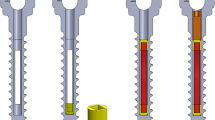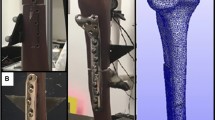Summary
The purpose of this research was to evaluate the structural stress and deformation of a newly designed onplant miniplate anchorage system compared to a standard anchorage system. A bone block integrated with a novel miniplate and fixation screw system was simulated in a three-dimensional model and subjected to force at different directions. The stress distribution and deformation of the miniplate system and cortical bone were evaluated using the three-dimensional finite element method. The results showed that the stress on the plate system and bone was linearly proportional to the force magnitude and was higher when the force was in a vertical direction (Y-axis). Stress and deformation values of the two screws (screw 1 and 2) were asymmetric when the force was added along Y-axis and was greater in screw 1. The highest deformation value of the screws was 7.5148 μm, much smaller than the limit value. The load was decreased for each single miniscrew, and the ability of the new anchorage system to bear the load was also enhanced to some degree. It was suggested that the newly designed onplant miniplate anchorage system is effective, easily implanted and minimally invasive.
Similar content being viewed by others
References
Costello BJ, Ruiz RL, Petrone J, et al. Temporary skeletal anchorage devices for orthodontics. Oral Maxillofac Surg Clin North Am, 2010, 22(1): 91–105
Sugawara J. Temporary skeletal anchorage devices: the case for miniplates. Am J Orthod Dentofacial Orthop, 2014, 145(5): 559–565
Sugawara J, Nishimura M. Minibone plates: The skeletal anchorage system. Semin Orthod, 2005, 11(1): 47–56
Meijer HJ, Kuiper JH, Starmans FJ, et al. Stress distribution around dental implants: influence of superstructure, length of implants, and height of mandible. J Prosthet Dent, 1992, 68(1): 96–102
Zhu S, Rong Q, Zhou Y. Study about the effect of implant length and diameter on stress distribution with finite element method. Chin J Orthodont (Chinese), 2006, 13(2): 49–52
Sugawara J, Umemori M, Mitani H, et al. Orthodontic treatment system for Class III malocclusion using a titanium miniplate as an anchorage. Orthod Waves, 1998, 57: 25–35
Liu L, Wu P, Wang M. Effectiveness of skeletal anchorage system in orthodontic treatment. Zhong Guo Shi Yong Kou Qiang Ke Za Zhi (Chinese), 2008, 1(1): 33–35
Ning Z, Liu L. Application progress of orthodontic treatment with titanium miniplate anchorage system. Zhong Guo Shi Yong Kou Qiang Ke Za Zhi (Chinese), 2013, 6(7): 439–442
Seres L, Kocsis A. Closure of severe skeletal anterior open bite with zygomatic anchorage. J Craniofac Surg, 2009, 20(2): 478–482
Tanaka E, Nishi-Sasaki A, Hasegawa T, et al. Skeletal anchorage for orthodontic correction of severe maxillary protrusion after previous orthodontic treatment. Angle Orthod, 2008, 78(1): 181–188
Schatzle M, Mannchen R, Zwahlen M, et al. Survival and failure rates of orthodontic temporary anchorage devices: a systematic review. Clin Oral Implants Res, 2009, 20(12): 1351–1359
Zeng X. Development, classification, and application of the skeletal anchorage system. Zhong Hua Kou Qiang Zheng Ji Xue Za Zhi (Chinese), 2005, 12(01): 44–48
Chen YJ, Chang HH, Huang CY, et al. A retrospective analysis of the failure rate of three different orthodontic skeletal anchorage systems. Clin Oral Implants Res, 2007, 18(6): 768–775
Choi SH, Jang SH, Cha JY, et al. Evaluation of the surface characteristics of anodic oxidized miniscrews and their impact on biomechanical stability: An experimental study in beagle dogs. Am J Orthod Dentofacial Orthop, 2016, 149(1): 31–38
Nagasaka H, Sugawara J, Kawamura H, et al. "Surgery first" skeletal Class III correction using the Skeletal Anchorage System. J Clin Orthod, 2009, 43(2): 97–105
Wang YC, Ko EWC, Huang CS, et al. Comparison of transverse dimensional changes in surgical skeletal class III patients with and without presurgical orthodontics. J Oral Maxil Surg, 2010, 68(8): 1807–1812
Cornelis MA, Scheffler NR, Nyssen-Behets C, et al. Patients’ and orthodontists’ perceptions of miniplates used for temporary skeletal anchorage: a prospective study. Am J Orthod Dentofacial Orthop, 2008, 133(1): 18–24
Esaki D, Matsushita Y, Ayukawa Y, et al. Relationship between magnitude of immediate loading and peri-implant osteogenesis in dogs. Clin Oral Implan Res, 2012, 23(11): 1290–1296
Melsen B, Verna C. Miniscrew implants: the Aarhus anchorage system. Sem Orthod, 2005, 11(1): 24–3120
Motoyoshi M, Inaba M, Ono A, et al. The effect of cortical bone thickness on the stability of orthodontic mini-implants and on the stress distribution in surrounding bone. Int J Oral Max Surg, 2009, 38(1): 13–18
Stahl E, Keilig L, Abdelgader I, et al. Numerical analyses of biomechanical behavior of various orthodontic anchorage implants. J Orofac Orthop, 2009, 70(2): 115–127
Amornvit P, Rokaya D, Keawcharoen K, et al. Stress distribution in implant retained finger prosthesis: a finite element study. J Clin Diagn Res, 2013, 7(12): 2851–2854
Clavert P, Zerah M, Krier J, et al. Finite element analysis of the strain distribution in the humeral head tubercles during abduction: comparison of young and osteoporotic bone. Surg Radiol Anat, 2006, 28(6): 581–587
Author information
Authors and Affiliations
Corresponding author
Additional information
This project was supported by the National Natural Science Foundation of China (No. 81171008).
Rights and permissions
About this article
Cite this article
Liu, L., Qu, Yy., Jiang, Lj. et al. Three-dimensional finite element analysis of a newly designed onplant miniplate anchorage system. J. Huazhong Univ. Sci. Technol. [Med. Sci.] 36, 422–427 (2016). https://doi.org/10.1007/s11596-016-1603-x
Received:
Revised:
Published:
Issue Date:
DOI: https://doi.org/10.1007/s11596-016-1603-x




